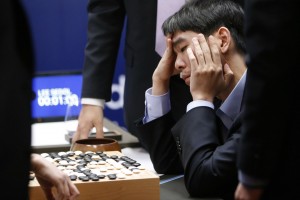AlphaGo: Implications for Machine Translation
Thursday, April 7th, 2016Machine defeats man at the game of Go.
The entire world was stunned at the 4–1 win by Google’s Deep Mind over Lee Se-Dol, one of the world’s best Go players. Some say that Deep Mind is a highly specialized intelligence that only knows how to play Go. But the principles, techniques, and algorithms underlying Deep Mind do in fact have wider application to so-called AI-complete problems. What do they mean for Machine Translation (MT)?
The development of go programs and machine translation programs have followed a parallel path.
The initial generation of solutions to both problems were based on “classical” AI techniques of encoding human knowledge. The go programs used rules of “good shape”, and human-style “reading”. The MT programs used grammars and rulesets built by human linguists. The results, in the case of go, were programs which played at the amateur sub-dan level (meaning the top 10% of all players). The results, in the case of MT, were programs which could at best produce vaguely understandable translations.


 Chinese researchers have analyzed the brains of go players with fMRI (
Chinese researchers have analyzed the brains of go players with fMRI (